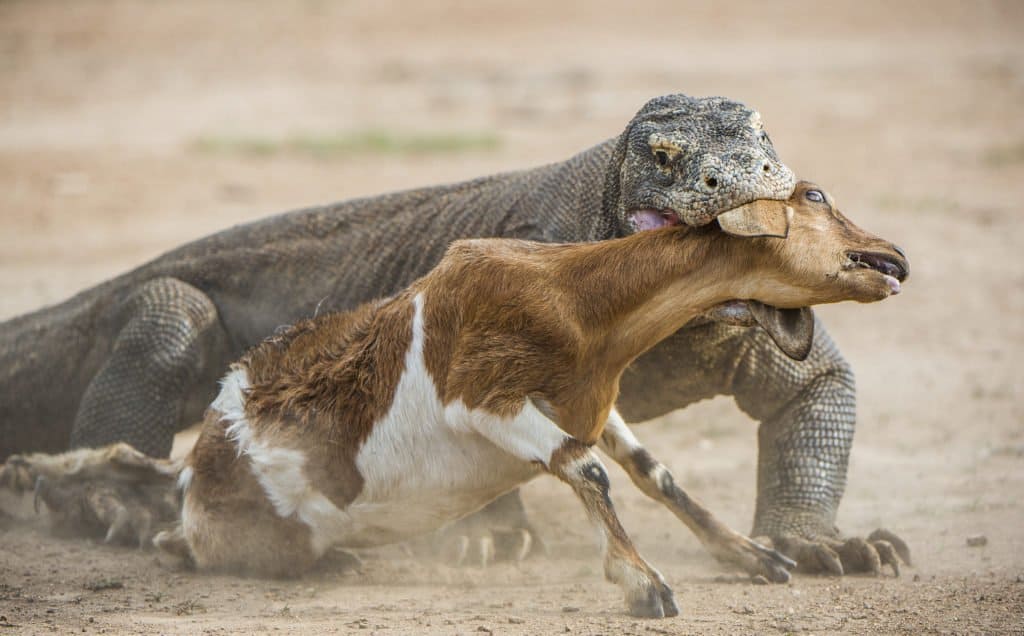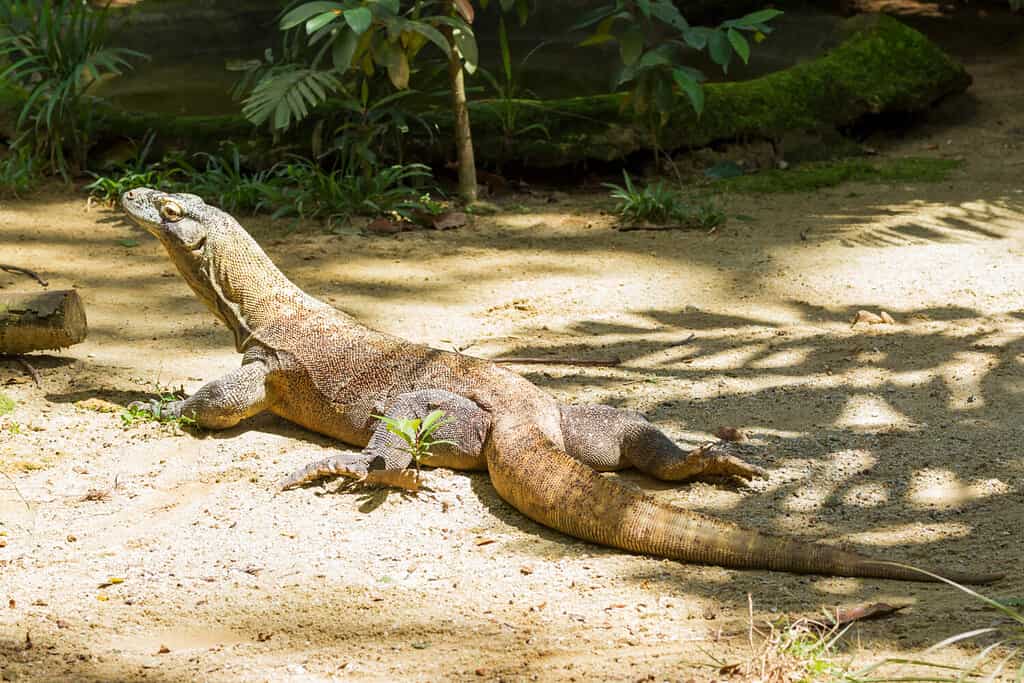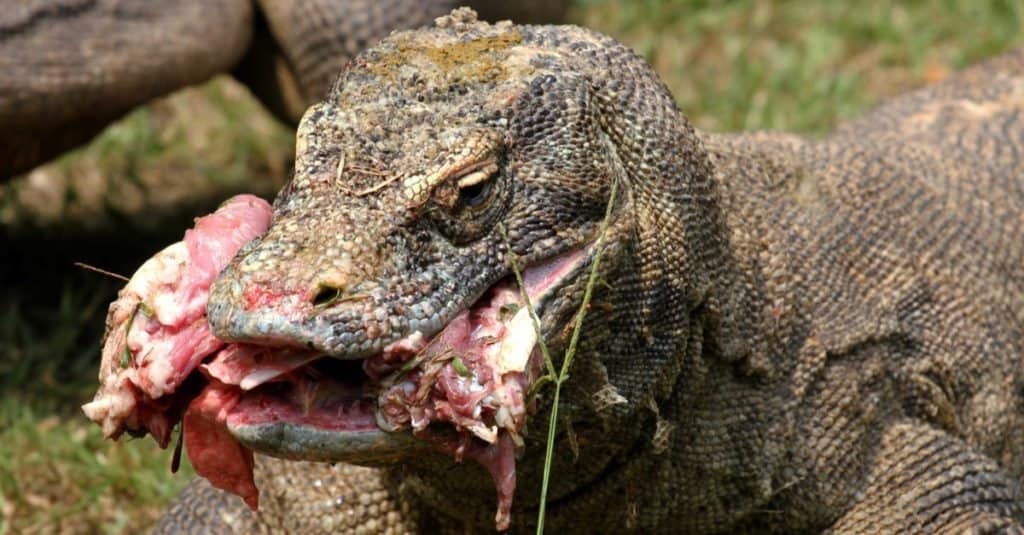If you thought alligators were scary, wait until you see this predator! The unstoppable Komodo dragon is chasing a frightened deer, who runs right into the ocean. At first glance, it appears the enormous dragon will lose its meal. However, within seconds, we realize this fierce lizard has no trouble plunging into the water, regardless of how intense the struggle may become. Follow along to learn more about the impressive Komodo dragon, and see the footage for yourself!
Watch the Wildlife Footage Below
Do Komodo Dragons Usually Eat Deer?

Komodo dragons can consume up to 80% of their body weight.
©Sergey Uryadnikov/Shutterstock.com
Does the Komodo dragon need to eat a whole deer? No, but it can and definitely will. Komodo dragons can consume up to 80% of their body weight in a single meal. And they’re happy to do so when the opportunity presents itself. However, they don’t need to eat that much. They can survive on 30 pounds of meat per month.
A Komodo dragon’s diet includes a variety of animals, from small rodents to large water buffalo. And they find these meals in a variety of tropical habitats. Komodo dragons live in tropical savanna forests ranging from beaches to ridge tops. Ridge tops are elevated areas along the points of mountains and hills.
Komodo Scales and Speed
Watching the video below makes it hard to tell just how rough the lizard’s skin is. But trust us, it’s rougher than the toughest sandpaper. These reptiles have thick, rough outer skin with thousands of bones underneath called osteoderms. Touching the scales would be similar to feeling rough, textured armor.
Along with being plated in armor, Komodos are also the largest lizards in the world, and they’re super fast. These reptiles can run up to 13 mph. As for defenses, they can throw up the contents of their stomachs within seconds to make a speedy escape should the need arise.
Biting and Pulling: Komodo Dragon Style

Komodo dragons don’t have the most powerful bite force but instead rely on their ability to pull flesh off.
©vladivlad/Shutterstock.com
Crocodiles, alligators, and Komodo dragons are large reptiles capable of killing prey as big as deer. But they go about it in very different ways. Unlike alligators or crocodiles, Komodo dragons don’t rely heavily on a strong bite force. Instead, they use their pulling skills to eat their food effectively.
Komodo dragons have a special way of eating that involves biting and pulling. Research has shown that they are particularly good at pulling down and back. This helps them gain the advantage while also removing flesh from their prey.
What other advantages does the Komodo dragon have when hunting? There are quite a few!
Komodo dragons use their sense of smell and long, forked tongues to detect prey. Once they find a tasty meal, they have everything they need to make the kill, including humongous teeth. Their large, curved teeth are arguably their deadliest weapon. And as if their size, senses, and strength weren’t enough of an advantage, they also have a venom gland in their lower jaw. The venom prevents blood clotting and induces shock.
The wildlife footage shows an unstoppable Komodo dragon making a meal out of a deer. Feel free to take a look for yourself! It’s fascinating.
Is It Normal Behavior for a Komodo Dragon to Chase a Deer into the Ocean?

The Komodo Dragon’s tail and webbed feet are great for swimming.
©Duc Huy Nguyen/Shutterstock.com
While it may not seem like normal behavior and part of normal hunting for a Komodo Dragon to capture and kill prey in bodies of water, the lizards certainly are well adapted to swimming. Ultimately, it was foolish of the deer to take flight into the ocean because Komodo Dragons can actually swim up to 12 mph! Their strong tails and webbed feet help them expertly swim. They can be found miles offshore in surrounding ocean waters and sometimes swim to nearby islands in search of food.
It is certainly normal for Komodo Dragons to chase their would-be meals in order to sink their teeth into flesh, and this particular prey just happened to be close to water, which gave the giant lizard a chance to match and overtake it in speed.
How Deadly is a Komodo Dragon’s Venom?

The sharp, serrated teeth of a Komodo dragon can tear and rip flesh, allowing for its toxic venom to enter the bloodstream and result in death if left untreated.
©Yudi S/Shutterstock.com
A Komodo dragon’s bite can be lethal, but not for the reasons you might imagine. Many predators in the wild like the lion or tiger, have superior bite forces, allowing them to kill their prey in such a manner. While the Komodo dragon has 60 sharp, serrated teeth that are no doubt painful if they chomped down on an animal or human, the bite force of this animal is fairly weak–500 to 600 PSI or 39 Newtons. Compare that to a saltwater crocodile, whose bite force is 252 Newtons.
The danger behind the Komodo dragon’s bite lies in the venom it generates. As their serrated teeth effectively slice open and rip flesh, their venom seeps into the wounds. The venom can put the victim into a state of shock, cause massive bleeding while preventing clotting, and decrease blood pressure–essentially incapacitating the victim. This venom quickens the blood loss process and sends the victim to lethargy or shock. If a human is attacked by a Komodo dragon, the venom can kill him or her in a matter of hours.
Thank you for reading! Have some feedback for us? Contact the AZ Animals editorial team.








